
SMS Marketing: Why It’s Time to Start Using Text Messages
SMS marketing used to be clumsy.
The image of it in most marketers’ minds is blast-heavy, poorly personalized — the email marketing of two decades ago, and more heavily regulated to boot.
But all those impressions are either false (SMS is regulated to the exact same extent as telephone marketing, by the same regulations) or they’re only partly true.
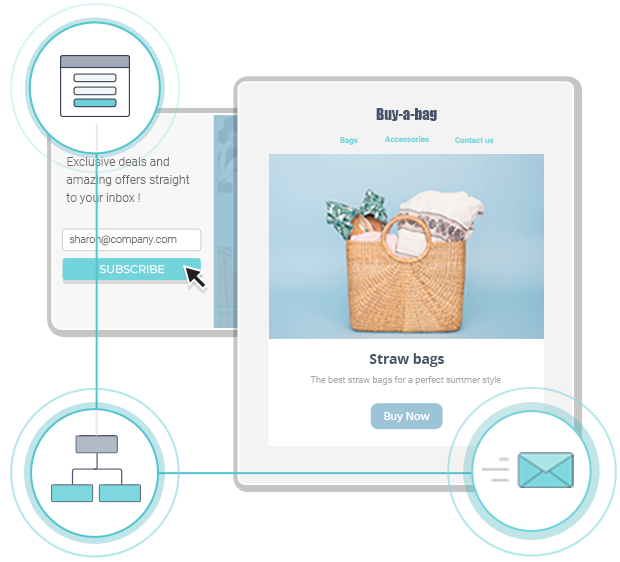
The easiest and most affordable email marketing and newsletter software!
SMS Marketing Overview
Yes, email marketers do sometimes rely on random blasts. If you’ve ever bought anything from a local takeout, or ridden with a local cab firm, you’ve been on the receiving end of this.
These messages are driven by what’s happening at their end, not what’s going on in your life.
They’re offering an extra 12” pizza for half the price, or asking you to fill out their survey to win a prize and they’re not gonna stop until every single soul on their list has been notified.
It’s not that marketing like that doesn’t work — it does. The same way even very poorly executed email marketing delivers results.
If it didn’t, your spam folder wouldn’t look the way it does: someone’s clicking on all those eager potential dates, questionable investment opportunities and even more questionable medical interventions.
The Reason Why Marketers are scared of SMS Marketing
Trouble is, it just doesn’t work very well. A local business can afford to be a bit careless, a bit clumsy — the same way they can afford to have poor onsite signage.
It’s better if they don’t but they can get away with it. Marketers and larger businesses — or businesses that aspire to be larger — know they can’t.
That’s why most marketers won’t touch SMS with a ten-foot pole and they advise their clients the same.
That view is outmoded. It’s now possible to take the same tools we’re used to employing in email marketing and bring them to bear on SMS marketing.
The result can be tightly targeted, highly personalized messages that appear to customers in the moment — more so than email can.
We’ve talked about the reasons people don’t use SMS marketing.
Now let’s look at the reasons why they should use it:
- SMS has killer engagement stats
- A measurable, trackable platform
- Interactive content
- Instant delivery and
- Near-instant response times
- Is highly personalizable
- Can be integrated into omnichannel marketing campaigns that also include IoT innovations.
SMS In the short Future
In the future, SMS will benefit both from forward-looking advances in technology and from its roots in a less-advanced era.
Let’s take each of these in turn, starting with engagement.
SMS Marketing Has Awesome Engagement
Email still is THE marketing channel.
It’s been proven over and over, so many times: if you want to sell things to people, get their email address (their real one!) and approach them the right way and email will be by far your best-ROI, highest-converting marketing channel.
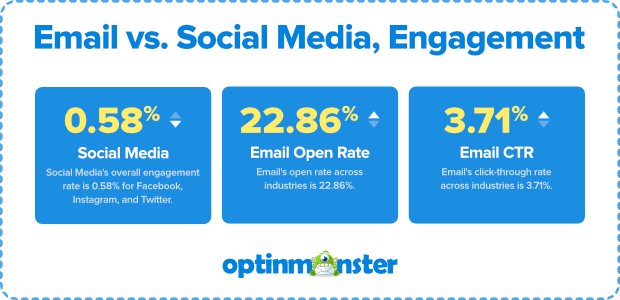
Except for maybe SMS.
Yes, really.
How many people are happy to receive promotional emails from a brand?
61% of consumers say they prefer to be contacted by email.
But… 75% are happy to be contacted by SMS.
Open Rates: SMS and Email
What about open rates? Email can score highly here. Across the board, email open rates hover around the 25% mark and are steadily growing.

Can SMS compete with this?
Yep. SMS open rates are around 95%. That’s not a typo — 19 in 20 SMS messages get seen.

They definitely get seen. But do they get a response, especially one that turns into profit for your business?
Again, SMS compares favorably with email here. I keep turning back to email because for all these metrics, it’s far and away from the best performer most marketers are familiar with: it’s the one to beat.
Response Rate: SMS and Email
Let’s look first at raw response rates: Any response counts.
Email response rates sit around 3% on average — yes, the very best email marketers can X2 or 3 this at least. But I’m comparing broad averages: like with like.
SMS response rates are around 45%. That’s 7.5 times higher.
And these responses are fast: around 60X faster than email responses.
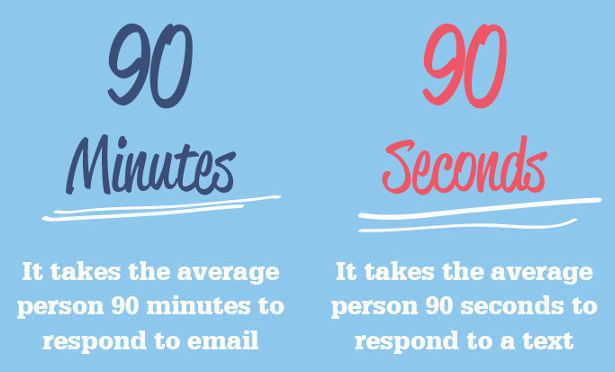
Are Those Responses Worth Your Time
As marketers, we all have to struggle, sometimes against temptation and sometimes against others in our organizations, to disregard vanity metrics and remain focused on growth and revenue metrics.
In other words doing business, rather than focusing on misleading numbers that can make it look like we’re acing our own section of the ‘funnel’ (blech!) while really we’re wasting time and effort, feeding weak leads on to sales and building an ‘audience’ instead of a customer base.
Unsurprisingly, this is reflected in the priorities of businesses that employ SMS: the majority set measurable, clear goals, aiming at either improved customer experience (34%), increased revenue (28%), or both (31%).
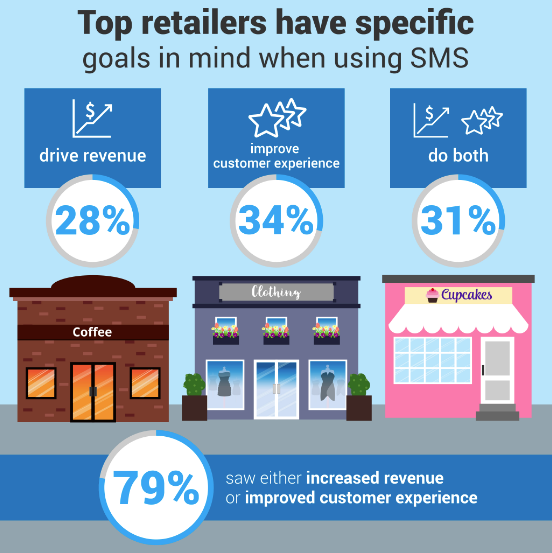
Over three quarters achieved those goals.
Does SMS produce customers and dollars?
For consumers, absolutely. Instore on-demand redemption rates for coupons are around 70%-80%, while out-of-store on-demand coupons are redeemed at around 40%.
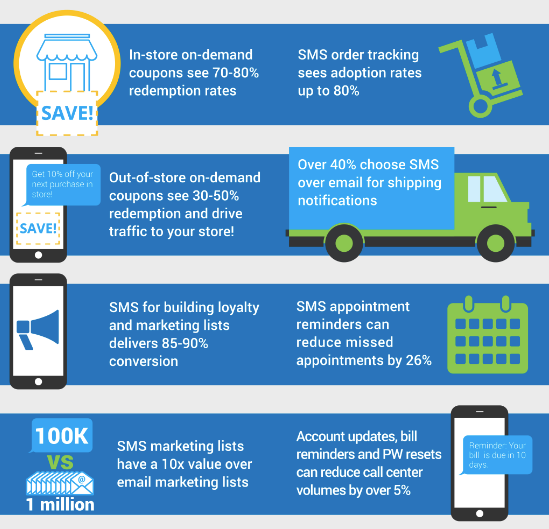
The value of SMS for consumer marketing is clear.
Bonus: Here are some additional SMS Tips by LocalFame.
What about B2B?
B2B SMS works most effectively in conjunction with email, where it can increase conversions radically.

Sending 3 or more texts after initial contact from an inbound B2B lead can more than 3X conversions.
SMS has excellent engagement and response metrics across industries and in both B2B and B2C.
SMS is Easy to Track and Measure
You can track and measure SMS in a quick-and-dirty, but effective way, by monitoring clicks on links in texts.
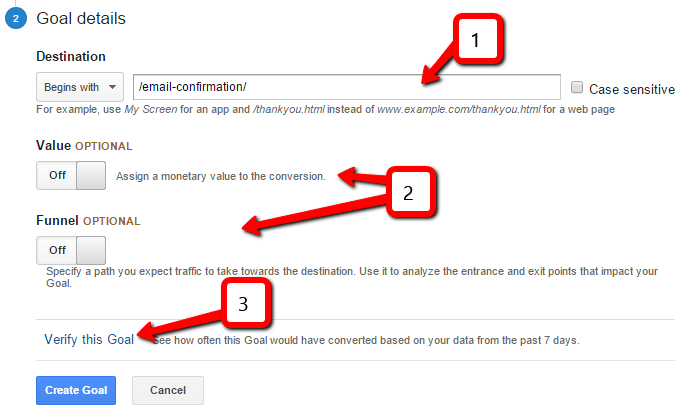
If you’re a bit of a Google Analytics ninja, you can build the whole conversion flows through custom landing pages (optimized for mobile, duh) on your site, and do the whole thing inside a single tool.
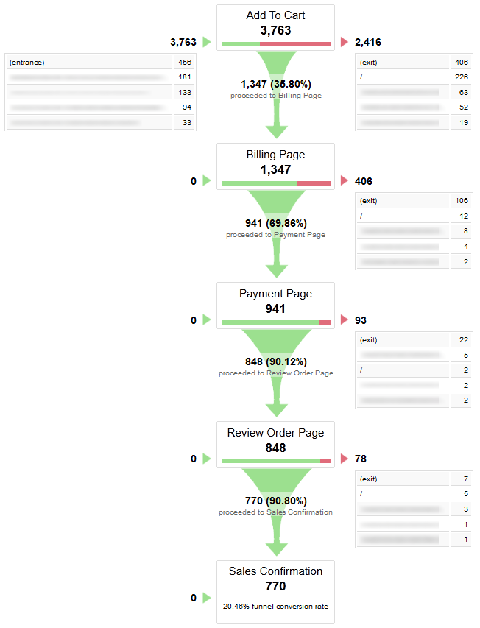
But what’s better is a platform that feeds you analytics in a more intuitive way, so you can stick to just being a marketing ninja and not need to master a sometimes-opaque analytics platform as well.
It’s even better if that same platform integrates with your email marketing flows, and lets you quickly build multichannel flows based on the most common use cases, with readymade ‘recipes’ that you just have to tweak, fill in and send…
Yes, we have one in the pipeline. Watch this space for a detailed breakdown of how it works!
It’s Easy to Make SMS Interactive
SMS can be made interactive easily. Even if the message itself is just text and links, the link can lead directly to highly interactive mobile web pages or web apps.
Check out how Chipotle does it.

Follow that link and you’ll be at a game, ‘’Cado Crusher,’ where you compete to get real prizes — free guacamole, in this case.
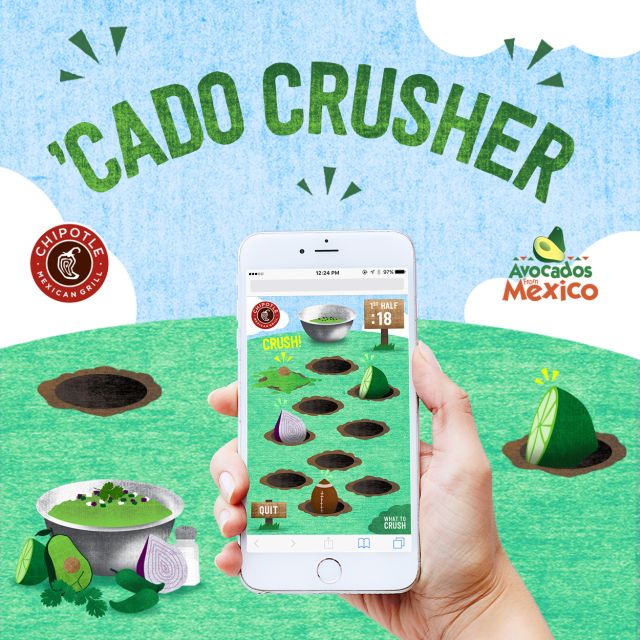
The promotion is over now, but while it ran, winners received their winnings by… SMS.
The standard marketing SMS is if anything even simpler — text a word or phrase to a indicate a simple affirmative, claim a coupon or enter a prize draw.
This has the advantage of letting you offer limited choices on a limited time frame to option-swamped consumers.
SMS Can be Integrated into Omnichannel Campaigns
For years now, marketers have been telling each other to stop looking at this channel or that channel and look at the customer instead.
Our customers read stuff on their phones, browse online stores on laptop and desktop, save Pins on tablets, then wander into stores to try things on and look for a coupon on their phone.
Customers care about the brand, message, relevance and value, but they don’t care about the channel.
So, we have to build marketing campaigns and strategies that aren’t channel-specific and reach customers wherever they happen to be, with the most appropriate tool at that moment.
Adobe sums it up:
SMS is a perfect fit for that approach.
We’ve talked about how SMS gets opened more and replied to more.
That’s great. But it also gets opened a lot faster. Like, usually within 90 seconds.
People check their emails — about 15 times a day, on average, which isn’t too shabby.
But they get SMS messages. 90 seconds is about how long it takes to get your phone out of your pocket and open your messages.
What Does This Mean for your Omnichannel Campaigns
If you have a time-sensitive offer, SMS is the channel to use.
SMS is an ideal channel for shipping and status updates, including delivery alerts. Shipping company Asendia opines, ‘providing your customers with timely tracking information from shipment through delivery is key for customer satisfaction.’
Text marketing doesn’t have to be time-sensitive: text messages can be an effective way to increase email sign-up rates, especially if they offer a reward for timely uptake.
Follow this link, sign up to our newsletter and claim your 20% off, your free pizza, your $5 gift card, your free audit.
Not only do mobile phones not have spam filters and the deliverability issues that can come with overactive security features in email inboxes, but they can also help you improve your email deliverability scores too.
RCS and SMS: The Past and the Future
SMS is a sharply restricted medium: no images, no design elements, no more than 160 characters.
Worse, they’re reliant on cellular networks, when the connection isn’t guaranteed and can easily be compromised by location or even bad weather; doesn’t sound like they can easily compete with size-unlimited, network-agnostic services like WhatsApp, which don’t care whether you’re using 4G or cafe wifi.
Yet, text messages remain a popular and effective means of communication. Is that despite the restrictions on content and length, or because of them?
We’ll soon know the answer to that.
The ‘next generation’ of SMS is RCS: Rich Communication Services.
RCS (as opposed to Short Message Service, which is what SMS stands for, in case you’re wondering) is the brainchild of smartphone manufacturers in tandem with the industry’s regulators.
RCS has existed for over a decade, but low uptake by handset manufacturers prevented the extensive spread of the technology.
Now, with backing from Google Fi, an RCS-based tool called simply Chat is poised to enter the market in a serious way.
Andy Shirey, senior product manager at SMS marketing company OpenMarket, says, ‘We like to call it the next evolution of SMS. It’s richer messaging content with features like reading receipts that are great to have.’
Smartphone market penetration is near-total now, so this next-gen SMS equivalent may have real legs, but it’s likely to continue to co-exist with traditional SMS for some time.
The future could include the seamless integration of SMS marketing in conversational commerce.
A number of online services already share order and shipping details over WhatsApp instead of traditional SMS.
Given that most customers now use third-party messaging apps to read and send text messages, the data collected by these apps could also be used for SMS remarketing purposes.
Anatomy of an SMS Marketing Message
By now, hopefully, you’re convinced: SMS marketing has a lot to offer. But how should you go about it to get the best effect?
SMS marketing has two components that you’ll need to understand to put your own messages together: the keyword and the shortcode.
The Keyword and Shortcode
The keyword is the word your customers’ text; the shortcode is the number they text it to.

Messages like this one are the archetypal SMS marketing message: interactivity is built in.
But there are others, asking for a different type of interaction; messages that ask for users to visit a certain link, or to reply with information.
Reminders, confirmations, and offers all look different, on the surface at least…
Whether they’re tracking products like this one…

Or reminding you of appointments like this one:

Or whether they’re pitching an offer like this one:

They all have similar underlying anatomy.
It’s very simple — at 160 characters max, it has to be.
Addressee, value, desired action. That’s pretty much it.
The more specific these three things are, the more effective the SMS message will be at getting the desired result.
SMS Marketing Examples
So an SMS that runs:
That’s weak. If you’re reading the Moosend blog, chances are you’re an experienced email marketer, so you’re already seeing the similarities.
The message above could be for anyone, and after reading it you have no idea what clothing, what kind of deal, or even where the store is. It’s not compelling or interesting.
How about this?
The ‘wedges’ joke is corny but lighthearted, but what really makes the difference?
- We know what this person likes, perhaps from their interaction with our email or website
- Our offer is specific: 20%, not ‘great deals’
- We’ve named actual items they might want
- There’s an action they can take with their thumb: follow the link to get the coupon
How to Implement SMS Marketing
SMS sounds like it could work for you, but how to do it?
1. SMS Marketing – Get permission
Like email, SMS is permission-based.
In the USA, SMS marketing is regulated by the FCC, under the TCPA and CAN-SPAM.
Transactional messages — your product has arrived, here’s your receipt — are exempt, but any other messages have to:
- Be sent via a shared shortcode and by associating a unique keyword with your campaign
- Opt-in only, with no third-party lists. Inform consumers, ask them to sign up for SMS, and keep records of sign-ups
- Easy to opt out: provisions to ‘text STOP to 555-555’ or equivalent. Users should be able to get off your SMS list easily
- Appropriate messaging: message content has to be appropriate to the audience that will receive it, not offensive, for instance.
In the EU, SMS is regulated by GDPR. That has several specific requirements:
‘Hard’ and ‘soft’ opt-in:
- ‘Hard’ opt-ins come when you get a clear yes to ‘can we contact you with marketing texts?’
- ‘Soft’ opt-ins are people who have been or currently are customers or inbound leads.
The big difference is that soft opt-ins are much more restricted:
If someone previously purchased food from you, for instance, that soft opt-in lets you contact them again with offers related to food.
What you can’t do is hand their contact details off to other parts of the company to text them about clothes, cosmetics or car parts.
To do that you need a hard opt-in, and to be valid, that has to be up-front and specific about what topics you’ll be contacting them regarding.
2. SMS Marketing – Know Your Customer!
Funnel all your feedback from your marketing efforts to your CRM, then power your SMS marketing campaigns with all that good data.
Website visits, phone calls, live chats, purchase history, social media and email marketing should all be feeding back data to your CRM, letting you build up an image of your customers you can use to target them with appropriate SMS offers.
Think of SMS as another piece of the marketing puzzle rather than another add-on or gadget; find the right place for it in your customers’ journeys.
But to do that, you have to know your customers, well enough to send them SMSs that match their interests.
For instance:
A regular customer visits your website, looking at a power saw.
Your email marketing system responds automatically, sending that customer a reminder that they didn’t buy it and telling them their local outlet has it. (If your email software doesn’t do that, well, ours does…)
Now, if they open that email and click the link to see where their local store is, you have a basis for sending them an SMS like this:
Send that out at random, and you’ll get 20 opt-outs for every sale. Send it to a customer you know, based on their actions, and you’re adding the right push at the right time to let them justify stopping by and getting their hands on all 710 watts of raw, reciprocating power.

3. SMS Marketing – Speak up
Text messages are read fast.
Be clear, not clever.
Say what you’re offering, and say what you want.
DONT YELL — all caps is for crazy people on the internet, not for getting people to relate to your brand and buy your products. The exception is your keyword — use caps to make it stand out from the text body.
And remember you have 160 characters. Direct is best.
Here’s what we have for you. Here’s what we want from you. That’s clear and simple.
Speaking of which…
4. SMS Marketing – Call to action
Marketing 101 applies here, too. If you want people to do something, tell them exactly what and make it easy.
Calls to action can request complex actions, or be the first step in a chain that only leads to purchase much later. The ‘Cado Crusher’ game we talked about earlier is a good example of that.
But they can be more direct too.
SMS Call to Action Examples
‘Show this text’ is a classic — encouraging engagement with the text message marketing program, and easy to have staff verify by eye with no other tools needed; no wonder it’s a favorite of the restaurant industry, for instance.
‘Click here’ is a winner if you’re building your SMS marketing into a wider digital campaign.
Mobile users love an action they can complete without taking their hand off their phone, and it’s an ideal opportunity to have users make an action you can use to gauge their willingness to interact while they get the map, code, or web page they need.
Text to win CTAs are a classic engagement-builder, sometimes overused by local businesses like taxicab companies, but still with substantial power if they’re used right.
Text to vote. People love to vote, to get their voices heard, and this is a powerful way to get your sign-ups to interact with your brand. (You can bundle it with competitions too if you like!)
Buy now, while stocks last and other urgency CTAs are best sent only to customers who have already indicated purchase intent.
When they have, 10% off and a reminder that there are only 7 of the item left in stock could be the difference between a sale and no sale.
5. SMS Marketing – Timing is everything
If you’re sending SMS that’s triggered by customer behavior, this is less of an issue, but still, remember that someone who opens an email at 3 AM may be insomniac or working odd hours; they’re definitely not about to take a trip to the store.
Don’t ask them to.
Keep SMS between 8 and 9, consider more restricted hours at the weekend.
Remember, if email is like a letter — it falls through your door, lies on the mat, and you can read it any time — SMS is kind of like knocking on someone’s door.
Don’t do it at 5am on a Saturday if you want to have a good relationship with them.
6. SMS Marketing – Make signing up easy
This is the exact same advice you’d give someone who’s setting out in the email marketing game.
Again, rather than give our granny egg-sucking lessons, we’ll keep it brief and just say: if you want SMS signups, put them everywhere you think your customers will want them.
In emails, on landing pages, on product pages, and in-store.
Once you have a sign-up, you can use it to expand the number of channels your customers opt in to — text them email opt-ins, for instance. Make it super-easy for them to take that first step.
Conclusion
SMS marketing is a natural component of a full digital marketing stack. Most businesses can benefit from it if it’s done right; in this post, we’ve leaned on local and B2C use cases, but there’s plenty of scope for B2B marketers to leverage SMS too.
The key factors are targeting, messaging and timing — just the same as for email marketing. (They’re such a natural fit that we’re bringing out an SMS marketing module at Moosend soon; watch this space for details…)
Use SMS as a blunt instrument, separate from your wider marketing efforts, and of course, your results will be disappointing; but build it into your wider strategy, and most importantly test it to see which tactics work best for your business, and you could see engagement and revenue leap.




 Published by
Published by 
 Published by
Published by 
this is great but I can’t find anywhere on how to actually set up Moosend with SMS marketing…